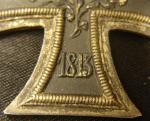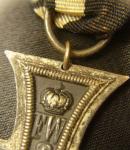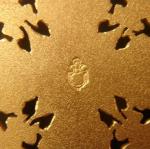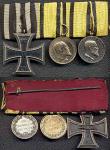-
Posts
146 -
Joined
-
Last visited
-
Days Won
1
Everything posted by Steve Russell
-
Apreciate the analysis guys. Andreas, I agree that the relationship between Herstellers certainly points to one firm making the materials for the less prominent others that vend them. For example, from what I have researched, the Godet die style seems to be found on Hemmerle, Meybauer, and Schickle variants. Les' fantastic analysis of Tim Tezer's PlM shows the Friedlander / Wagner relationship. Les, I agree with the principle of what you are saying on the arm center gap. I am trying to get a visual. Are you saying the gap is narrower or broader in the later post-war pieces? If broader, the Meybauer / Godet pieces seem very tight. The issued Godet pieces appear identical in appearance to the Meybauer, Hemmerle and Schickle types. We know that pie-wedge pieces were sold by jewelers during the war as Ernst Udet purchased one in late March 1918 from a jeweler in Berlin. That would rule out Hemmerle. Schickle is unlikely given the known advertisements during the TR period. That would leave Godet or Meybauer as possibilities. This is why I believe that these Godet and Meybauer type pie-wedge non-issued pieces could pre-date the 1920s. Great discussion. Steve
-

EK 1914 EK II - A real stumper
Steve Russell replied to Steve Russell's topic in Germany: All Eras: The Iron Cross
No comments as to why the double reverses? Thanks, Steve -

EK 1914 EK II - A real stumper
Steve Russell replied to Steve Russell's topic in Germany: All Eras: The Iron Cross
And the side for the last pic. Measurements are 44mm overall and each arm is 24mm on the edge. Has anyone ever seen one like this? Steve -

EK 1914 EK II - A real stumper
Steve Russell replied to Steve Russell's topic in Germany: All Eras: The Iron Cross
-

EK 1914 EK II - A real stumper
Steve Russell replied to Steve Russell's topic in Germany: All Eras: The Iron Cross
-

EK 1914 EK II - A real stumper
Steve Russell replied to Steve Russell's topic in Germany: All Eras: The Iron Cross
You're not seeing double. It is the same cross. It is very well made. The reverse looks (both of them!) looks like many of the other brass examples I have seen. My guess is that since these were made late in the war, it was an unintended double strike? Or what? Here are more pics. -

EK 1914 EK II - A real stumper
Steve Russell replied to Steve Russell's topic in Germany: All Eras: The Iron Cross
-
I posted this at the WAF but would value the opinions of the larger Imperial audience here. I bought this cross on eBay and was excited about getting it because from the pics, the crown and letters looked exactly like the late war solid brass pieces. The seller listed it as an 1813 Iron Cross. I thought, well not really, turn it over and there will be the 1914. The ribbon is perfect and original, the ring is soldered and the quality is good for this type of Brass 'Iron' Cross. And the paint is fairly intact. Here is a pic of the obverse.
-
Thanks Andreas and thanks Wild Card. Wild Card, I have numerous photos of vets wearing two different PlMs and agree that the wearer's copies certainly existed. It would be hard for anyone to dispute that. But what I have yet to find is anyone that can prove that the Meybauers were only made in the post war period. I do not believe they were because they were such a major producer of EKs, badges and other awards, many with the same hallmarks. @ Daniel Cole. I know the piece you are talking about. I, too, picked one up for next to nothing years ago because it looked pretty good for the fakes. The enamel work was outstanding and it even had a mark on the back that says Ges. Gesch. Probably made in Germany. I am glad I kept it. It turns out to be a promotional piece for the very first showing of the movie 'The Blue Max' in 1966. Jack Hunter was even selling a couple of them on Der Rittmeister that belonged to him and his wife (for $125.00 each!). While I don't always trust his judgment on real PlMs given the number of Rothes and Spanish fakes that appear there, I have to concede that he would be the expert on the movie promotional medals. Here are pics of mine. Does yours look like this one? Steve
-
Well Wild Card, I am no expert either but I have studied the one-sided pieces quite a bit because of the Meybauer PlM I own. Here is what I have learned in a nut shell. - One sided PlMs existed, the main manufacturer being Meybauer. - Most believe that these pieces were for funeral pillows, but I can find no evidence on the Meybauers that this was their stated purpose. Meybauer produced the full-range of military awards, so why would their PlM not be in the same league as say Wagner or Godet? - I can find no evidence yet that the Meybauers were 'issued.' - I believe the Meybauer obverses were made on the same dies as Godet because nearly every detail is identical. One PlM recipient was known to have worn a Meybauer piece to all the PlM reunions. - I can find no evidence that the Meybauer PlMs were NOT produced during the war. I suspect they were given that they produced all the other awards. We know they were produced in the 1920s. If anyone has evidence to the contrary on my findings thus far, it would be MOST welcome and no offense taken at all. This is just what I have found out thus far. As to the the piece that started this post, several things do it in. I have yet to see any original piece from any maker that has the 'hook' at the top of the 'l' in 'le.' The eagles are very poor and the cut outs on the legs make a poor showing for any jeweler serious enough to handle Germany's highest award. This piece screams fake. Here are some pics of my one-sided Meybauer.
-
I love the one jonightflyer posted. It certainly isn't one of the run of fakes from Austria or Spain. Enamel and workmanship are right in there with all the other good pieces. And as Les has pointed out in other posts and confirmed here by Tim, the connected letters do appear on known examples prior to the S&Ls. The S&Ls are such a give away with their blunt eagle legs, that the connected letters should not be a disqualifyer or an automatic S&L piece. The blunt leg versions are late pieces. This one looks very, very good. What a 'tall' story on von Schleich! Interesting too, that most of Der Ritt's pieces are Rothes. I've not seen one yet that would fall in line with anyting that Tim, Les or jonightflyer list here. Steve
-
Sam, The bar looks OK to me. I remember seeing it listed and liked it at well. The Zinc ones can have less definition. The numerals on these Schwarzburg medals are stylized with cross-hatches midway on the number. Looks like the definition on the lower half of the first number one was either filled or worn off. Hard to tell from the pics. Here is a zincer 3 bar to compare with.
-
The two offerings on Der Rittmeister's site appear to be Rothe-style fakes. The mini on the top offering is a Spanish-style fake and the most common fake mini out there. I have to say that the crowned-headed mini on the second offering could be legit. Hard to say. While orginal pre-WWI Rothe's are known to pop up, the enamel work on the top piece is very, very poor. The bottom piece looks more like the modern Rothe style copies. It is very good workmanship and the enamel is much better. Might have been a legit modern-made Rothe piece but it is still a copy akin to the Souval TR awards made decades after the war. As a general rule, the 'fishbone' style tail feathers on the eagles usually keep the serious PlM collector away. Steve
-
Good eye Stogie on the center ribbon stitching. Didn't catch that before. I wish I could provide larger pics but two problems: 1) I have no idea who the bar belongs to. Stored the pics a long time ago and forgot where it came from. and 2) Even if it were available to me, I can't post anything larger than 65k because I am still 'probationary.' Not sure why and I found no info on how to overcome the status. Thanks! Steve
-
And here is the same style 'Spanish' fake(?) on a real Godet 2-er EK, HK knopfloch being offered currently on eBay. Note the poorly drilled hole on the band. Ashame that, while common, an orignal Godet knopfloch was damaged to do this bit of trickery. At least that is my opinion. Thoughts? Steve [attachmentid=62900]

















